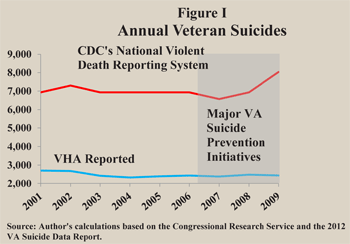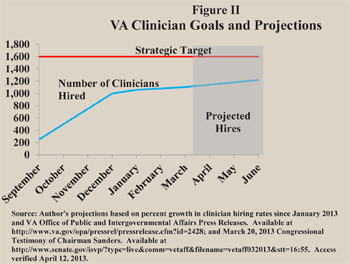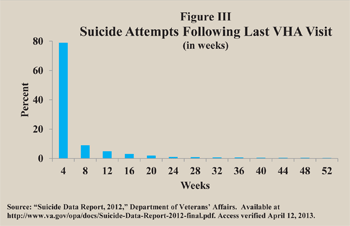Veterans who do seek treatment receive only minimally adequate care — defined as receiving prescribed drug therapy and visiting a doctor once every three months, or seeing a mental health professional once every seven weeks. Further, poor implementation and limited geographic reach leave elderly and rural veterans three times more likely than the general population to commit suicide.1
The quality of Veterans Health Administration (VHA) care for suicide risks often surpasses private hospitals; for instance, VHA patients are more likely than private hospital patients to receive screening tests and treatment with appropriate medications. However, 61 percent of veterans are not enrolled in the VHA, and therefore do not receive treatment from the Department of Veterans Affairs (VA). The VA’s community-based health care clinics offer fewer services than VHA hospitals, leaving rural and elderly veterans without the treatment needed to reduce suicide risk factors. Veterans represent only 7 percent of the population, but 22 percent of all reported suicides. Suicide is quite literally “ravaging the veteran population.”2

Veteran Suicide Rate. The VA currently uses two different measures to track veteran suicides — neither of which is comprehensive [see Figure I]: the suicide rate among VHA enrollees and aggregate state data from veterans’ death certificates. The VHA figures do not include the 13.4 million (61 percent) of veterans who are not enrolled in the VHA. However, according to surveys, about 5 million of these veterans believe they have service-connected disabilities and suicide risk factors requiring treatment.3
The other suicide report, the Centers for Disease Control’s (CDC) National Violent Death Reporting System (NVDRS), attempts to measure veteran suicide rates at a national level, but receives data from less than half of the states. For example, California and Texas have the largest veteran populations, but they did not produce data for the 2012 Veteran Suicide Report. Despite VA and CDC efforts, incomplete and erroneous state suicide reporting to the NVDRS contributed to an error rate in excess of 23 percent for the best available data.4 Indeed, no one knows just how many veterans are at risk for, or commit, suicide each year.
Effectiveness of Preventive Measures. Over the past few years, the VA has taken a number of steps to improve its suicide prevention efforts. In 2007, only 5 percent of VA facilities employed a suicide prevention coordinator to train VA staff, identify high-risk veterans and monitor their care. By 2009, 99 percent of VA facilities had suicide prevention coordinators. Figure I shows that the VA’s Suicide Hotline fielded 500,000 calls from 2007 to 2009 (represented by the shaded area).5 And, over the past five years, the Crisis Hotline has scheduled 73,000 next-day appointments or interventions.6
Despite the increases in preventive measures, there were nearly 75,000 reported suicide attempts over the past five years, and an additional estimated 57,000 successful suicides. The VHA’s reported suicide rate increased 2 percent, and the CDC’s reported suicide rate increased 16 percent (partly due to the inclusion of data from more states).7
One explanation for the increase in suicides among veterans enrolled in the VHA is inadequate treatment provided by VHA hospitals and clinics. In 2012:8
Only 15 percent of veterans with a primary diagnosis of post-traumatic stress received the minimum of eight recommended psychotherapy sessions within a 14-week period.9
The number of individuals with PTSD evaluated at required intervals to determine the severity of their symptoms has not been reported since 2010, and even then only 5 percent were evaluated; whereas, the VHA’s goal is to treat 80 percent of PTSD patients by 2015.
Veterans diagnosed with depression-related conditions who visit community-based outpatient clinics average only one treatment annually.10
Shortage of Mental Health Professionals. The VA website hosts a search engine where veterans can input their area code to find community-based outpatient clinics (CBOCs) or vet centers, but nearly two-thirds (64 percent) of VA outpatient clinic staffs do not have a mental health clinician — a professional providing treatment, such as a psychiatrist, psychologist, social worker, nurse, nurse practitioner or pharmacist. Charles Curie (formerly of the Substance Abuse and Mental Health Services Administration) argued that VA Secretary Eric Shinseki’s aggressive recruiting strategies have pulled mental health professionals away from clinics and into fulltime staff positions at VA hospitals.11 Pressed by Congress, President Obama signed an executive order authorizing Secretary Shinseki to hire 1,600 new mental health clinicians by the end of June 2013, in order to reallocate personnel and increase access to care for rural and elderly veterans. However, some 70 percent of VA mental health professionals surveyed said that existing clinics do not have enough space to accommodate the incoming workers.12

Figure II illustrates the projected number of mental health professionals, based on VA has hiring rates since January 2013:
From September 2012 to January 2013, the VA hired around 1,100 clinicians.
Between January and March of 2013, they hired only 47 more; and, if this trend continues, the VA will be several hundred clinicians short of its June 2013 goal.
Federal law requires that all veterans who request mental health services from the VA receive an initial evaluation within 24 hours and a comprehensive evaluation within 14 days. However, in April 2012 some veterans waited as long as 60 days for an evaluation.13 Unfortunately, the 2012 VA Performance and Accountability Report does not indicate the number of veterans who receive the required care within 24 hours of requesting help.
The VA blames mental health clinician shortages for the poor access to care. In turn, clinician shortages have isolated veterans by forcing them to travel to urban VA Medical Centers to receive treatment. The inconvenience of traveling and waiting to receive care explains why veterans were “no shows” for more than 20 percent of their mental health appointments last year.14

From 2010 to 2012, the number of veteran suicides remained constant at 22 deaths every day, one every 65 minutes.15 Unfortunately, there appears to be a strong correlation between veterans receiving treatment through the VHA and suicide. Only half of veterans who attempt suicide are VHA participants; but as Figure III illustrates, 80 percent of suicide attempts by VHA enrollees occur within one month of receiving VHA services.
Short-Term Policy Solution: Increase VA Cooperation with Veterans Service Organizations. According to Senator Richard Burr (R-N.C.), ranking member of the Senate Committee for Veterans Affairs, and multiple reports by the Congressional Research Service, there is a clear need for increased cooperation between the VA and Veterans Service Organizations (VSOs). Partnering with VSOs like Give an Hour — a nonprofit organization that connects veterans with free local mental health care professionals in their community — would allow hotline operators to schedule local follow-up appointments days after a crisis, not months. Such cooperative efforts would also allow veterans access to free treatment during that first critical month, when most suicides occur.
Moreover, many veterans simply do not understand their benefits, and are often left unaware of the seriousness of their suicide risk due to a lack of responsible media reporting. Media attention would not only increase the number of clinicians willing to participate in critical organizations such as Give an Hour, but would also stimulate current VA outreach programs.
Long-Term Policy Solution: Health Savings Accounts. Although the VA allows eligible patients to carry private insurance, it strongly encourages them to stay within the VA system. The majority of veterans have both VA and private insurance, according to public health expert Kenneth Kizer. Fragmented coverage, Kizer insists, leads to decreased quality of care.16 VA-eligible patients with private insurance are less likely to use VA care, preferring to seek more accessible care from providers in their own community.17
A “GI Health Care Bill” could provide eligible veterans with the resources to purchase a high-deductible health insurance policy plus a Health Savings Account (HSA). Veterans and their employers should have the opportunity to put premium savings in a tax-free HSA to pay medical bills or to purchase health insurance. Allowing veterans to find care within easy reach would significantly increase their access to care, and would also increase the number of veterans who actively seek care.18
Such a policy shift would require the VHA to provide much more convenient care options. Currently, for example, the VHA will not fill prescriptions from third-party clinicians, and veterans face long waits for necessary treatments at distant VA facilities in order to be eligible for VA prescription mailing services. Thus, veterans are faced with either rationing by waiting, or paying out of pocket for expensive medications. Because most veterans prefer to use private insurance to receive treatment, a GI Health Care Bill should allow prescriptions to be forwarded from a private physician to the VA and then dispensed directly to the veteran through existing infrastructure. This change would reduce costs for veterans and increase the likelihood that they receive care.
Conclusion. The VA has proved unable to provide effective treatment, or to accommodate veterans who want help where they live. Additional funding without effective oversight will not solve the problem. Policy changes are necessary. Congress should also consider allowing veterans to purchase Health Savings Accounts with their VA benefits.
The VA should encourage community-based support networks by partnering with the myriad Veteran Service Organizations and private clinicians willing to help in a community-based setting. These strategies have the potential to vastly increase access to care and outreach; doing so could reduce the alarming rates of veteran suicide.
Kyle Buckley is a graduate student fellow with the National Center for Policy Analysis and a veteran of the U.S. Army.
Endnotes
1. Katherine E. Watkins et al., Veterans Health Administration Mental Health Program Evaluation: Capstone Report, RAND Corporation, 2011. Available at http://www.rand.org/pubs/technical_reports/TR956.html. Access verified May 7, 2013.
2. Erin Bagalman, “Suicide Prevention Efforts of the Veterans Health Administration,” Congressional Research Service, R42340, January 10, 2013. Available at https://www.fas.org/sgp/crs/misc/R42340.pdf. Access verified May 8, 2013; and A. J. Frances, DSM5 in Distress: The Epidemic of Suicide in the Military, Psychology Today, September 19, 2012. Available at http://www.psychologytoday.com/blog/dsm5-in-distress/201209/the-epidemic-suicide-in-the-military.
3. This study focuses on the VA mental health system. A previous NCPA paper explored problems with the VA’s disability benefits system. See Pamela Villarreal and Kyle Buckley, “The Veterans Disability System: Problems and Solutions,” National Center for Policy Analysis, Backgrounder No. 166, December 2012. Available at http://www.ncpathinktank.org/pub/bg166.
4. “Suicide Data Report, 2012,” U.S. Department of Veterans Affairs.
5. Terry Tanielian et al., “Invisible Wounds of War,” Rand Center For Military Health Policy Research, 2008. Available at http://www.rand.org/content/dam/rand/pubs/research_briefs/2011/RAND_RB9594.pdf. Access verified May 8, 2013.
6. Erin Bagalman, “Suicide Prevention Efforts of the Veterans Health Administration,” Congressional Research Service, R42340, January 10, 2013.
7. Ibid.
8. Katherine E. Watkins et al., Veterans Health Administration Mental Health Program Evaluation: Capstone Report.
9. “2012 Veterans Affairs Performance and Accountability Report,” U.S. Department of Veteran Affairs. Available at http://www.va.gov/budget/report/. Access verified on April 12, 2013.
10. John Fortney et al., “Implementation outcomes of evidence-based quality improvement for depression in VA Community Based Outpatient Clinics,” Implementation Science, July 30, 2012. Available at http://www.ncbi.nlm.nih.gov/pubmed/22494428. Access verified April 16, 2013.
11. Guy Gugliotta, “VA Drive to Hire 1,600 Mental Health Professionals Hits Community Clinics’ Supply,” Kaiser Health New, April , 2013. Available at http://www.kaiserhealthnews.org/Stories/2013/April/07/VA-hiring-mental-health-professionals-impact-on-community-health-centers.aspx?p=1. Access verified April 16, 2013.
12. “Statement of Senator Richard Burr, Ranking Member, Senate Committee on Veterans’ Affairs, Hearing on VA Mental Health Care, March 20, 2013.” Available at http://www.veterans.senate.gov/hearings.cfm?action=release.display&release_id=924acbb2-2bb4-4cbf-8be8-7e0273b1a9a3. Access verified April 16, 2013.
13. “VHA Review of Veterans’ Access to Care,” VA Office of Inspector General, April 23, 2012. Available at http://www.va.gov/oig/pubs/VAOIG-12-00900-168.pdf. Access verified April 12, 2013.
14. “2012 Veterans Affairs Performance and Accountability Report,” U.S. Department of Veterans Affairs.
15. Ibid.
16. Kenneth Kizer, “Veterans and the Affordable Care Act,” Journal of the American Medical Association, Vol. 307, No. 8, February 22, 2009. Available at http://jama.jamanetwork.com/article.aspx?articleid=1356002. Access verified May 8, 2013.
17. “VHA Treatment of PTSD and TBI among Recent Combat Veterans,” Congressional Budget Office. Available at http://www.cbo.gov/sites/default/files/cbofiles/attachments/02-09-PTSD.pdf. Access verified September 14, 2012.
18. “Invisible Wounds of War,” Rand Center For Military Health Policy Research.